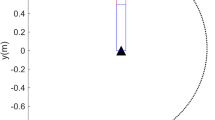Abstract
This paper proposes the collision-avoidance trajectory design and simulation of a virtual kinesthetic feedback system. The system has two sliders driven in two tracks, respectively, and produces virtual masses when the user holds and moves the system. Trajectory planning considering both the ideal and constrained scenarios in applications is carried out. A collision-avoidance trajectory is designed based on the quintic polynomial, and the influence of the time interval and the switching point is discussed. Simulations were performed to verify the function of the system. The results show that without constraints, the system can produce prescribed virtual masses. The displacements of the slider are affected by the error between the prescribed virtual mass and the real mass of the system. With the constraints of the tracks' lengths, the produced virtual masses are altered from the prescribed. Adjusting the time interval and the switching point could optimize the performance of the system when the geometric parameters of the system are set.
Similar content being viewed by others
References
J. Moen, From hand-held to body-worn: embodied experiences of the design and use of a wearable movement based interaction concept, Proc. of the 1st International Conference on Tangible and Embedded Interaction, Baton Rouge, LA, USA (2007) 251–258.
A. Chang and C. O'Sullivan, Audio-haptic feedback in mobile phones, Proc. of Extended Abstracts on Human Factors in Computing Systems, Portland, OR, USA (2005) 1264–1267.
M. Bergamasco, Manipulation and exploration of virtual objects, Artificial Life and Virtual Reality (1994) 149–160.
P. Laitinen and J. Mawnpaa, Enabling mobile haptic design: piezoelectric actuator technology properties in hand held devices, Proc. of the 2006 IEEE International Workshop on Haptic Audio Visual Environments and Their Applications, Ottawa, ON, Canada (2006) 40–43.
J. Luk, J. Pasquero, S. Little, K. Msclean, V. Levesque and V. Hayward, A role of haptics in mobile interaction: initial design using a handheld tactile display prototype, Proc. of the SIGCHI Conference on Human Factors in Computing Systems, ACM Press, New York, USA (2006) 171–180.
C. Swindells, A. Unden and T. Sang, TorqueBAR: an ungrounded haptic feedback device, Proc. of the 5th International Conference on Multimodal Interfaces, Vancouver, BC, Canada (2003) 52–59.
T. Amemiya, H. Ando and T. Maeda, Lead-Me Interface for a pulling sensation from hand-held devices, ACM Transactions on Applied Perception, 5 (3) (2008) 15.1-15.17.
Y. Tanaka, S. Masataka, K. Yuka, Y. Fukui, J. Yamashita and N. Nakamura, Mobile torque display and haptic characteristics of human palm, Proc. of the 10th International Conference on Artificial Reality and Telexistence, Osaka, Japan (2001) 115–120.
H. Yano, M. Yoshie and H. Iwata, Development of a nongrounded haptic interface using the gyro effect, Proc. of the 11th IEEE Symposium on Haptic Interfaces for Virtual Environment and Tele-operator Systems, Los Angeles, CA, USA (2003) 32–39.
N. Nakamura and Y. Fukui, Development of a force and torque hybrid display "GyroCubeStick", Proc. of the IEEE First Joint Eurohaptics Conference and Symposium on Haptic Interfaces for Virtual Environment and Teleoperator Systems, Pisa, Italy (2005) 633–634.
D. Kostic, B. D. Jager, M. Steinbuch and R. Hensen, Modeling and identification for high performance robot control: an RRR-robotic arm case study, IEEE Transactions on Control Systems, 12 (6) (2004) 904–919.
B. A. Helouvry, P. Dupont and C. D. Wit, A survey of models, analysis tools and compensation methods for the control of machines with friction, Automatica, 30 (7) (1994) 1083–1138.
L. Cao and H. M. Schwartz, Stick-slip friction compensation for PID position control, Proc. of the American Control Conference, Chicago, IL, USA (2000) 1078–1082.
C. M. Gosselin, A. Lecours, T. Laliberte and F. Lessard, On the development of a programmable inertia generator, Proc. of the 13th International Symposium on Experimental Robotics, Quebec City, Canada, 33 (4) (2012) 489–506.
K. Wang, M. Z. Luo, T. Mei, J. H. Zhao and Y. Cao, Dynamics analysis of a three-DOF planar serial-parallel mechanism for active dynamic balancing with respect to a given trajectory, International Journal of Advanced Robotic Systems, 10 (23) (2013) 1–10.
Author information
Authors and Affiliations
Corresponding author
Additional information
Recommended by Associate Editor Yang Shi
Kun Wang received the Ph.D. from the Department of Automation, University of Science and Technology of China, Hefei, Anhui, China, in 2013. She is currently an assistant professor at the Center for Robotics Research, School of Mechanical Engineering, Jiangnan University, Wuxi, Jiangsu, China. Her research interests include bioinspired robotics and mechatronics systems.
Xuan Wu received the Ph.D. from the Department of Precision Machinery and Precision Instrumentation, University of Science and Technology of China, Hefei, Anhui, China, in 2015. He now serves as an assistant research fellow in the Institute of Advanced Manufacturing Technology, Hefei Institutes of Physical Sciences, Chinese Academy of Sciences, Changzhou, Jiangsu, China. His research interests include MEMS/NEMS, biomechanics, and bioinspired robotics.
Rights and permissions
About this article
Cite this article
Wang, K., Gosselin, C., Wu, X. et al. Collision-avoidance trajectory planning for a virtual kinesthetic feedback system. J Mech Sci Technol 30, 3321–3330 (2016). https://doi.org/10.1007/s12206-016-0641-4
Received:
Revised:
Accepted:
Published:
Issue Date:
DOI: https://doi.org/10.1007/s12206-016-0641-4




